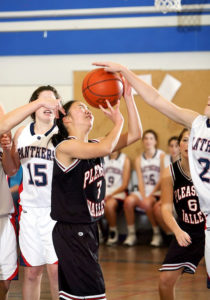Developing consistency throughout all levels of your program
It’s a must for varsity coaches to take an active part in developing players during their early years of competitive play. This gives all players a head start when they reach the high-school level. It’s almost impossible to have high school players who are years behind in knowledge of the game and basic fundamentals catch up with the rest of the field.
 The following are ways you can get involved with the younger players and programs.
The following are ways you can get involved with the younger players and programs.
Elementary/youth programs
• Help choose the right coach. Try to avoid letting a parent or hometown fans coach the team. There are exceptions, but many youth coaches care more about winning games or making their child look good than teaching fundamentals and instilling a love for the game in players.Try to have a member of your coaching staff or another teacher assume the coaching responsibilities. Discuss with the coach things that need to be taught to young players.
• Develop interest. Create ways to get young players interested in basketball. Offer them a summer basketball camp or a weekend basketball clinic during the varsity season. Give out awards prizes and trophies to contest winners to build excitement and competition.
• Encourage attendance at varsity games. Hand out free game passes to elementary students or have a few “elementary nights” where all elementary students get into your games for free. This sparks their interest in basketball, increases your game attendance, and can make playing varsity basketball a future goal for local kids.
• Age-appropriate skills & coaching concepts. Specific things need to be taught to players in the elementary grades. Teaching the fundamentals and rules of the game are important, but so are other things to make basketball fun and exciting to them.
Develop a habit of regular practice attendance. Sell the kids on the importance of practicing at home during recess. Play everyone, and have fun in practice and games.
• Create interest. Promote sportsmanship and teamwork. Teach proper shooting form, basic footwork, dribbling with the head up (and with both hands), basic passes, defensive stance, basic man-to-man defensive principles, proper layups with both hands, blocking out, rebounding and playing with hustle.
Junior high/middle school programs
It’s important for you to get involved with the program at the junior high and middle school level.
• Talk to the junior high coach regularly. Outline the skills that you need players to be able to perform by the time they enter high school. Be specific. Teach them how to coach it if they do not know.
• Arrange summer camps. Offer to organize a summer basketball camp for the junior high coach, and give him or her offseason workout guidelines.
• Help with tryouts. Kids who are cut from the team in junior high usually never play again. Help make sure the right players are being retained.
• Treat the junior high coach like a member of your staff. Take the junior high or middle school coach to coaching clinics with your staff. The more knowledge the coach has, the better coached the players will be by the time you get them in high school.
• Attend practices and games. Watch the junior high practice whenever possible, and allow junior high coaches to sit in on yours. Attend their games. The coach and players need to see that you’re interested in their program.
» RELATED: How varsity coaches can help their junior high counterparts
• Age-appropriate skills & coaching concepts. Give a list of required player skills to the junior high coach at the beginning of the season. It’s important that he or she understand that you aren’t trying to take over the program, but are offering basic guidelines to help blend the two programs together.
There are specific skills that junior high players need to learn before they enter a high school program. They are:
- Offensive skills and proper shooting form.
- Dribble and pass proficiently with right and left hands.
- Proper footwork squaring up and how to set and use a screen.
- Basic post moves (post players) passing to the post (guards) techniques blocking out and rebounding.
- The varsity offense. Whether it’s a motion offense or a continuity, it’s important for the players to understand the basics before entering the high school program. They should also know a simplified version of the varsity secondary break.
- Defensive skills such as proper stance techniques and advanced man-to-man principles.
- The varsity zone defense. If you only use one zone defense, it’s pointless for the junior high team to learn a different one. If you are a pressing team, teach players the varsity’s full-court defense.
- Other areas such as the varsity numbering system (1 man, 2 man, etc.).
Emphasize hard work and dedication. The players must be accustomed to playing hard in practice and games, and be dedicated to improving.









